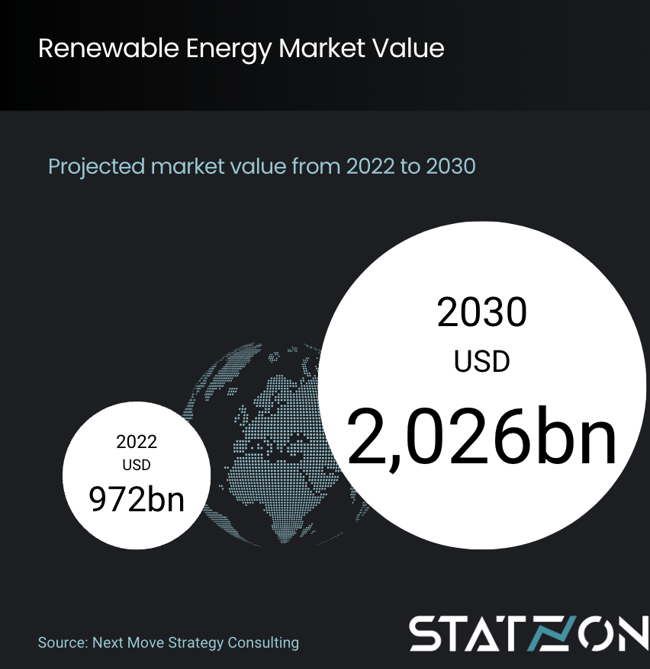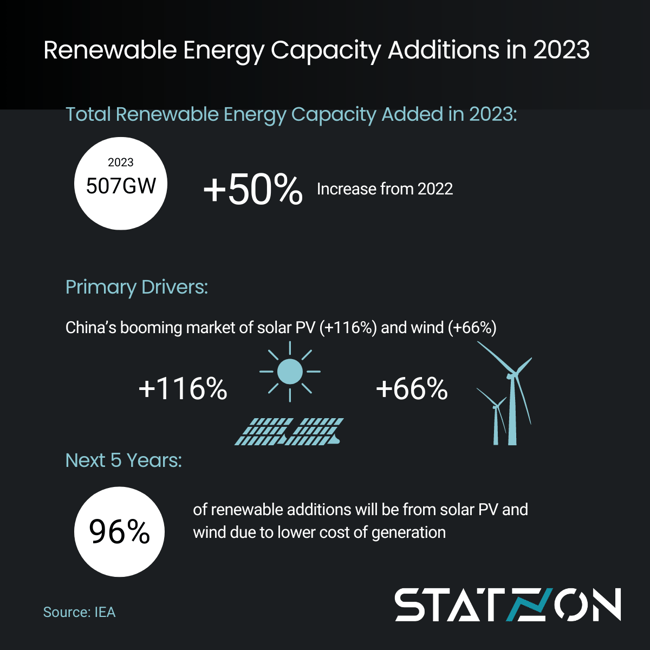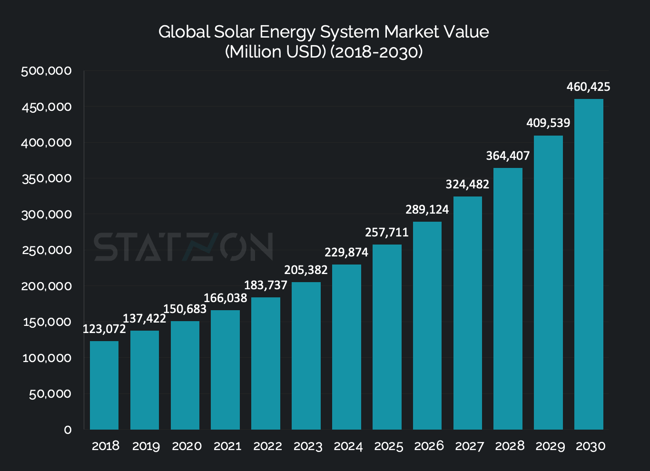The global energy sector is undergoing a transformative shift beyond adopting new energy sources due to the urgent need to combat climate change and promote sustainability. Nations and organizations worldwide are embracing renewables like solar, wind, hydrogen, and geothermal as clean alternatives to fossil fuels, fundamentally changing our energy landscape.
This transition aims to reduce greenhouse gas emissions, enhance energy security, and reduce reliance on finite fossil fuels. The renewable energy sector is not only innovative but also a major job creator, fostering advanced technologies and signaling a shift towards a resilient, sustainable energy infrastructure.
This shift is not just about environmental benefits; it catalyzes economic growth. The renewable energy sector, already a powerhouse of innovation and job creation, generated USD 972 billion in revenue in 2022.
In 2023, around 507 gigawatts (GW) of new renewable electricity generation capacity were added globally, marking a significant increase of nearly 50% from the additional capacity installed in 2022. This upward trend is expected to continue over the next five years, with solar and wind power anticipated to constitute about 96% of the total additions because their generation costs are lower than for both fossil and non-fossil alternatives in most countries.
To address the challenges faced by countries worldwide, especially developing nations, the International Renewable Energy Agency (IRENA), outlines several urgent actions needed to overcome structural and systemic barriers that are slowing the energy transition.
IRENA emphasizes the need to modernize infrastructure and streamline permitting for renewable projects to ensure fast and sustainable development. The agency also highlights the importance of integrating the energy transition into national economic strategies, aligning policies across sectors to accelerate renewable deployment. Additionally, developing a skilled workforce and increasing financial investment are crucial steps to tripling global renewable energy capacity by 2030.
Solar Energy
Having reached what seems to be an irreversible tipping point, solar power is poised to dominate global electricity markets in the coming decades. The market value of this sector reflects its growing prominence: according to the market research firm 360iResearch, the global solar power market is currently growing at a 12.17% CAGR with the market value projected to more than double from USD 183.7 billion in 2022 to USD 460.5 billion by 2030.
This surge in market value is a testament to solar energy's transition from a niche application to the most economical and rapidly expanding power source globally. Its widespread availability and the cycle of increasing investments have significantly improved its economic appeal. The technology's simplicity and scalability have led to substantial cost reductions and rapid deployment, further cementing its position in the energy mix.
By mid-century, solar PV is expected to lead the energy sector, driven by declining costs that are projected to fall well below those of alternative sources. Expanding industrial supply capacity for solar energy is also a key factor in this growth.
The momentum behind solar energy suggests its emerging dominance in the global electricity market, a trend that appears robust and potentially unstoppable, even without new climate policies.
Wind Energy
Wind energy is a key player in the renewable energy sector, with its use growing significantly in recent years. Small wind turbines, capable of producing 100 kilowatts of power, have become a popular choice for residential use, providing enough energy to power a home. Larger turbines, mounted on structures up to 80 meters high with 40-meter rotor blades, can generate 1.8 megawatts, suitable for commercial and industrial use. The largest turbines, on 240-meter structures with over 162-meter blades, can produce 4.8 to 9.5 megawatts.
Wind-generated electricity can be used immediately, distributed through the electrical grid, or stored for later use. Since 2000, wind power has seen rapid growth due to advancements in technology, supportive policies, and decreasing costs. From 7.5 GW in 1997, global wind generation capacity rose to approximately 733 GW by 2018. In 2021, wind power generation increased by 260 TWh, a 17% rise from the previous year and the largest growth among all power generation technologies. By 2022, wind electricity generation reached 2,145 TWh, a 16% increase from 2021, with China and the United States leading in production. Wind power is the dominant non-hydro renewable technology, contributing significantly to global electricity generation.
Hydroelectric Power
Hydropower, with its extensive network of approximately 50,000 large dams and millions of smaller ones, plays a pivotal role in the world's renewable energy sector. These dams are instrumental in producing 17% of global electricity through hydropower generation. This energy source not only exceeds the electricity generated by nuclear power but also surpasses the combined output of wind and solar energy. In certain areas, such as Brazil, hydropower's contribution to electricity generation is even more significant, reaching around 70%.
In 2022, hydropower generated 4,300 TWh of electricity, a 2% increase in comparison to the previous year. The hydroelectric power market, as per Next Move Strategy Consulting’s report, is set to grow at a CAGR of 7.6% from 2022 to 2030, with an estimated value of USD 349 billion in 2022 and a projected increase to USD 626 billion by 2030.
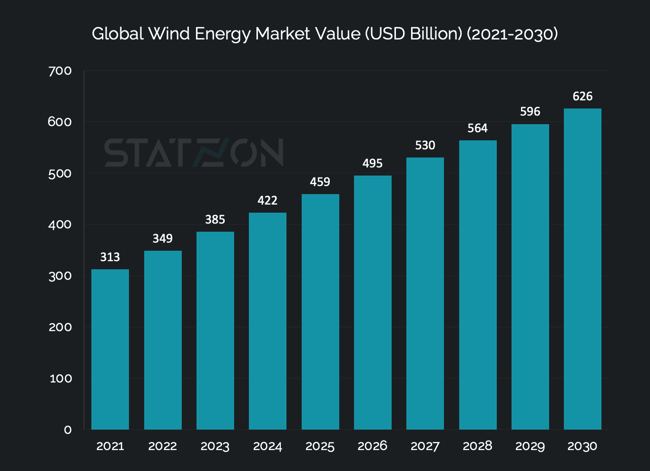 Source: Statzon/ Next Move Strategy Consulting
Source: Statzon/ Next Move Strategy Consulting
Bioenergy
Bioenergy, generated from burning biomass fuels like harvest residues, purpose-grown crops, and organic waste, is a key form of renewable energy. Traditional bioenergy, involving the basic combustion of materials such as wood and agricultural waste, is inefficient and emits high levels of pollutants, leading to significant air pollution and health issues. In contrast, modern bioenergy employs advanced technologies for converting biomass into cleaner energy forms like biofuels, electricity, and heat. These methods, including gasification and anaerobic digestion, are more efficient and environmentally friendly, significantly reducing emissions and aligning with efforts to mitigate climate change.
As the largest source of renewable energy globally, modern bioenergy accounts for 55% of renewable energy and over 6% of the total global energy supply. The bioenergy market, estimated at USD 127 billion in 2022, is projected to grow to USD 203 billion by 2032, expanding at a CAGR of 4.8%, as reported by Apollo Research Reports.
Geothermal Energy
Geothermal energy, a notable renewable power source, capitalizes on the Earth's natural heat reservoirs to generate electricity. It harnesses the energy locked within the Earth's crust by tapping into underground hot water or steam reservoirs, utilizing this heat to drive turbines, ultimately producing clean and sustainable electricity. While geothermal energy boasts immense potential, it currently represents a modest 0.5% of the global renewable-based electricity generation and heating/cooling capacity. In 2022, the worldwide net geothermal installed capacity for electricity generation reached 14.9 GW, with an annual growth rate of approximately 3.5%. However, its significance is set to expand significantly in the context of the broader clean energy transition, supported by a projected global geothermal energy market worth USD 66 billion by 2030, as reported by Next Move Strategy Consulting.
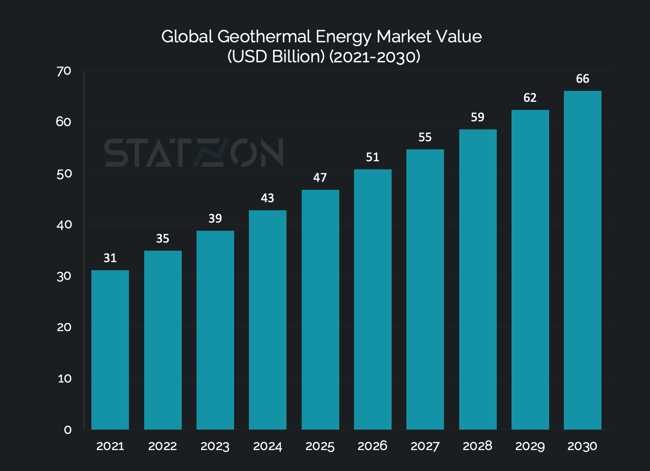 Source: Statzon/ Next Move Strategy Consulting
Source: Statzon/ Next Move Strategy Consulting
Geothermal resources are particularly abundant in regions characterized by volcanic activity, including countries like Iceland, Turkey, parts of eastern Africa, and those encircling the Pacific Ring of Fire—an expansive belt in the Pacific Ocean known for volcanic and seismic activity, encompassing areas of Indonesia, the Philippines, and the United States.
In the forthcoming years, the accelerated deployment of geothermal energy will be driven by advancements in geothermal technologies, multifaceted collaborations across industries related to geothermal, and an increasing emphasis on geothermal applications for heating and cooling. A significant portion of the additional geothermal wells needed to attain this growth are expected to be situated in high-enthalpy regions, notably in Indonesia.
Hydrogen
The hydrogen market is experiencing rapid growth due to the increasing demand for clean energy solutions and advancements in hydrogen production and application technologies. Key sectors driving this expansion include energy storage, fuel cells, and industrial uses, particularly in ammonia production and refining processes. Government initiatives, subsidies, and investments in hydrogen infrastructure are crucial factors bolstering this market, especially in regions like Asia-Pacific, North America, and Europe.
Trends in the hydrogen market feature significant facility expansions, strategic partnerships, and technological innovations. Companies focus on improving hydrogen generation methods such as steam methane reforming, electrolysis, and coal gasification. The rise of green hydrogen, produced through renewable energy sources, is also noteworthy, given its potential to significantly reduce carbon emissions.
Forecasts indicate substantial market growth, with the hydrogen market projected to reach remarkable milestones by 2032. For instance, the hydrogen fuel cell market alone is expected to achieve USD 155 billion by 2032, highlighting the increasing adoption of hydrogen as a clean energy carrier. This growth is supported by ongoing research and development efforts to enhance the efficiency and cost-effectiveness of hydrogen technologies.
In summary, the hydrogen market is poised for robust growth driven by technological advancements, government support, and increasing demand for sustainable energy solutions. The market’s future looks promising, with significant opportunities for innovation and investment across various sectors. For more detailed insights and specific data, refer to Statzon’s comprehensive overview.

Decentralized Energy Systems and the Vital Role of Energy Storage
The trend toward decentralized energy systems is gaining momentum due to regulatory support and the need for seamless integration of renewable energy sources and enhanced grid flexibility. This shift involves moving away from traditional centralized power plants to a more distributed and localized approach, where power generation is diversified and distributed across smaller-scale sources like solar panels, wind turbines, and small-scale hydroelectric systems. This optimizes renewable energy utilization, reduces fossil fuel dependency, and enhances eco-efficiency by bringing power sources closer to end-users while minimizing transmission and distribution inefficiencies.
However, a critical challenge in this transition is effectively managing the intermittent nature of renewable sources like wind and solar. This is where energy storage technologies play a crucial role. Energy storage solutions, including advanced battery storage systems and grid-scale facilities, serve as the cornerstone for maximizing the benefits of decentralized energy systems. They capture surplus energy generated during high renewable output, storing it for later use during peak demand or when renewables aren't producing electricity, thereby enhancing reliability and stability in decentralized energy systems while optimizing sustainable resource utilization.
The synergy between decentralized generation and energy storage is vital for a resilient, sustainable, and flexible energy landscape. This collaboration ensures continuous, reliable energy while reducing emissions and promoting renewable adoption, aligning with global efforts to combat climate change and meet rising energy demands.
Energy Storage Market
Energy storage is becoming increasingly important in the shift to renewable energy. It plays a key role in improving energy efficiency, ensuring security, and providing a steady supply of renewable power. Beyond just storing energy, it ensures that sources like solar and wind can reliably power systems, even when they're not producing electricity. This is where grid flexibility comes in. Energy storage not only strengthens grid reliability but also improves power quality, helping the grid adapt to changes in renewable energy generation. This flexibility is essential for incorporating more renewable energy into our power systems, making energy storage a crucial part of sustainable energy infrastructure.
Take solar panels, for instance, they are the cheapest source of electricity today, but without effective storage, their potential remains underutilized. To make solar energy work well in our grids and plan for more capacity, strong storage systems are needed. These systems are crucial for handling renewable energy's ups and downs, ensuring we have power when we need it most.
Reflecting these needs, the market for energy storage systems is experiencing rapid growth. Valued at USD 7.3 billion in 2022, it's projected to surge to USD 29.5 billion by 2032, according to Apollo Research Reports. This growth trajectory is driven by the global push to integrate variable renewable energy (VRE) sources more effectively into power systems. The demand for system flexibility and the ability to store energy efficiently is at the heart of this market expansion. By 2026, the cumulative installed storage capacity is forecasted to reach over 270 GW, a significant increase from 2020, with battery storage expected to lead this growth.
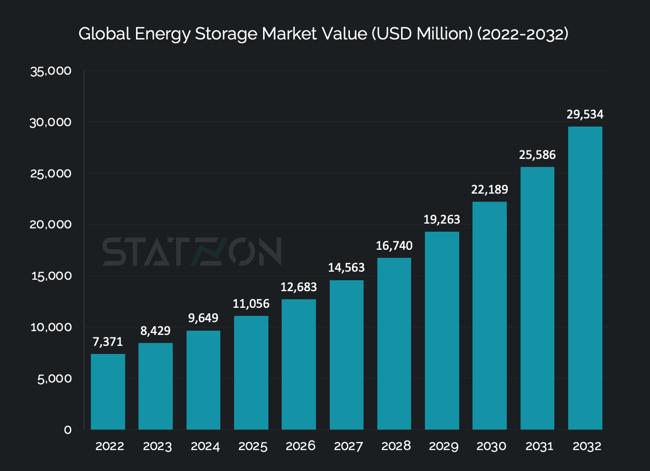 Source: Statzon/ Apollo Research Reports
Source: Statzon/ Apollo Research Reports
Energy Storage as A Service
Energy Storage as a Service (ESaaS) represents a groundbreaking shift in the world of sustainable energy solutions. It offers a flexible and cost-effective approach to energy storage, enabling both individuals and organizations to access the benefits of energy storage without the complexities and upfront expenses associated with traditional systems. ESaaS operates on a subscription model, providing users with virtual power bank-like capabilities, enhancing energy reliability, and reducing environmental impact.
When combined with Distributed Energy Storage Systems (DESS), ESaaS becomes even more powerful. DESS integrates numerous small-scale energy storage units into a network, creating a decentralized and resilient energy ecosystem. ESaaS optimizes and manages these distributed storage assets efficiently, contributing to grid flexibility and supporting the integration of renewable energy sources.
The ESaaS market is already valued at USD 1.3 billion, and it's projected to reach USD 3.1 billion by 2032, reflecting a CAGR of 9.24% from 2023 to 2032, based on data from Apollo Research Reports. Customer Energy Management Services and Ancillary Services stand out as significant contributors to this market's growth. These services empower users to efficiently manage their energy needs, optimize consumption, and enhance grid stability.
Source: Statzon, National Geographic, nature.com, Bloomberg, European Parliament, IRENA, BCG, IEA (1), IEA (2), IEA (3), IEA (4)

Related Editor's Highlights
